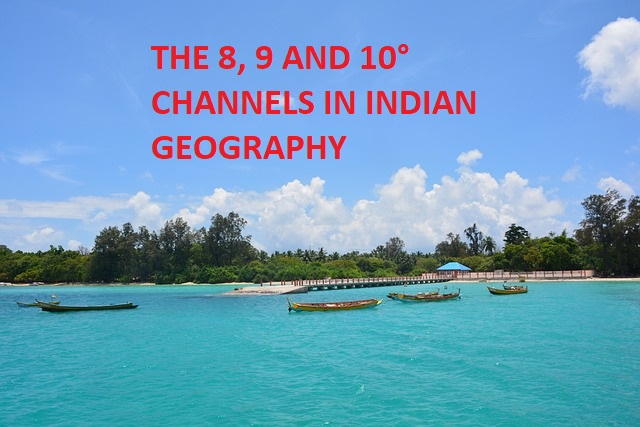What Is 8 9 and 10° Channel In Indian Geography?
What is 8 9 and 10° Channel In Indian Geography? I am sure you must not have. When I came to know about these 8 9 and 10° channel, I was very excited to share it with my friends through this blog article. It is important for all the competitive exams and Heritage quiz. Indian geography is as diverse as it is enchanting, with a myriad of unique features that set it apart. Among these geographical wonders, the 8 9 and 10° Channels stand out as fascinating maritime passages that have played a significant role in the history, culture, and commerce of the Indian subcontinent. Remember, these are not related to the 8 9 and 10° and longitudes or latitudes.
Defining the Degrees
Do you know that the 8, 9, and 10 ° Channels are primarily maritime channels.
It is situated in the Indian Ocean.
They are extremely crucial for maritime trade, international navigation, and even a hint of geopolitics.
8° Channel:
It separates India’s Andaman & Nicobar Islands with Indonesia.
This channel is located between the southernmost tip of India’s Andaman Islands and the northernmost tip of Indonesia’s Island.
It is important for navigation between the Bay of Bengal and the Andaman Sea.
9° Channel:
9 Degree is situated further to the south.
Separates the islands of Minicoy from the main Lakshadweep Archipelago.
It is 200 km wide and approximately 2500 m deep.
The 9 Degree Channel separates the Little Andaman with Great Nicobar.
The Little Andaman, which belongs to India is separated from the Great Nicobar Island, which is part of the Indian union territory.
It is an important route for shipping in the region.
All the ships coming from Middle-East, Europe, West Asia and South – East Asia passes through 9 Degree channel.
Therefore, it has a very strategic importance.
10° Channel:
10° is located to the south of the 9 ° Channel.
It separates Andaman Islands with the Nicobar Islands.
It is 150 km wide.
From east to west it is 10 km wide with a depth of approximately 7 meters.
This passage divides the Car Nicobar island, an Indian territory, from the Nancowry Group of Islands.
Similar to the other channels, it is a key navigation route for ships and has strategic importance.
It is named so because the 10 degree latitude separates Andaman with Nicobar islands.
What Is 8 9 and 10° Channel In Indian Geography?
Historical Significance
These channels are vital for contemporary maritime activities.
Also held historical significance.
During the colonial period, the British recognized the importance of these channels for trade and control of the Indian Ocean.
They established lighthouses and naval bases along these passages to safeguard their interests.
The 8 Degree Channel, in particular, has played a role in the history of World War II.
It was the site of naval battles and skirmishes as the British attempted to secure the region against Japanese advances.
Geopolitical Significance
These channels also have geopolitical importance in modern times.
Their location are critical to India’s maritime (SEA COAST) security.
They serve as entry points to the Indian Navy’s Eastern and Western Fleets.
Furthermore, their proximity to the Strait of Malacca, one of the world’s busiest shipping lanes, highlights their strategic significance.
Additionally, the 8 Degree Channel has been a subject of discussion between India and Indonesia.
This is because of the overlapping Exclusive Economic Zones (EEZs) of both the nations.
However, resolving these maritime boundary issues has been a subject of diplomatic negotiations.
Biodiversity and Ecology
The waters surrounding these channels are also known for their rich biodiversity.
The coral reefs (for which Lakshadweep is known for marine life), and the lush underwater world are treasures of the Indian Ocean.
The conservation of these ecosystems is essential.
These ecosystems support the livelihoods of coastal communities.
Exploring the Enigmatic 8 9 and 10° Latitudes in Indian Geography
Indian geography is a tapestry of diverse landscapes, cultures, and climates.
It’s a land of extremes, from the snow-capped peaks of the Himalayas to the sun-soaked shores of the Indian Ocean.
In this rich tapestry, there are some fascinating latitudinal lines that are worth exploring: the 8th, 9th, and 10th degrees of latitude in Indian geography.
The 8th Degree: A Glimpse of the Southern Tip
The 8th degree of latitude in India marks the southernmost extent of the mainland.
It is a region that offers a unique blend of geographical and cultural diversity.
Kanyakumari, located near this latitude, is the southernmost point of the Indian subcontinent.
Moreover, it is renowned for its spectacular confluence of three major water bodies: the Arabian Sea, the Bay of Bengal, and the Indian Ocean.
You can see here the Vivekananda Rock Memorial and Thiruvalluvar Statue.
These two iconic landmarks, stand proudly at this southern tip, reflecting India’s cultural and spiritual diversity.
The 8th degree also encompasses the beautiful state of Kerala, known for its lush greenery, backwaters, and serene beaches.
The tropical climate here is quite distinct from the rest of India, and it has earned Kerala the nickname “God’s Own Country.”
The 9th Degree: A Passage to the Plains
As we move north from the 8th degree, we arrive at the 9th degree of latitude.
It is home to a fascinating diversity of landscapes.
This line passes through the southern part of Tamil Nadu.
It touches cities like Madurai and Ramanathapuram.
Moreover, It also crosses over into parts of Andhra Pradesh and Karnataka.
Madurai, is one of the oldest continuously inhabited cities in the Indian subcontinent.
It falls very close to the 9th degree.
The city is renowned for its majestic Meenakshi Temple, a magnificent example of Dravidian architecture.
As we move further north along this latitude, the terrain changes dramatically, transitioning from the hills of the Western Ghats to the Deccan Plateau.
This transition is a testament to the geological diversity that characterizes India’s landscapes.
The Deccan Plateau, with its vast expanse of flat lands, is a vital region for agriculture.
The 10 °: The Lush Green Corridor
The 10th degree of latitude in Indian geography traverses the western coast of the subcontinent, passing through the states of Kerala, Karnataka, Goa, and Maharashtra. This region is blessed with an abundance of natural beauty and is characterized by the lush Western Ghats.
One of the most famous cities along this latitude is Goa, renowned for its stunning beaches, vibrant nightlife, and Portuguese-influenced architecture. The 10th degree also touches parts of the Konkan coast in Maharashtra, which is known for its lush greenery, rice paddies, and charming coastal towns.
The Western Ghats, a UNESCO World Heritage Site, are an essential ecological hotspot in this region. The ghats are home to numerous endemic plant and animal species and play a crucial role in regulating the monsoon patterns in India.
What Is 8 9 and 10° Channel In Indian Geography?
Conclusion
The 8, 9, and 10° Channels in Indian geography are more than just lines on a map. They have stories to tell – tales of history, diplomacy, trade, and ecology. These maritime passages are a testament to the interconnectedness of our world, where geography and geopolitics meet. As we navigate these waters, we can appreciate the rich tapestry of India’s geography and the role it plays on both the local and global stages.
India’s 8th, 9th, and 10th degrees of latitude offer a captivating journey through the country’s diverse landscapes and cultures. From the southernmost tip of the subcontinent in Kanyakumari to the lush greenery of Goa and the Western Ghats, these latitudes showcase the geographical and cultural richness of India.
Exploring these latitudes not only reveals the stunning diversity of India’s landscapes but also allows us to appreciate the unique historical and cultural tapestry that defines this incredible nation. Whether you are a traveler, a geographer, or simply a curious explorer, these latitudes offer an exciting passage through the heart of India’s geography.





0 Comments